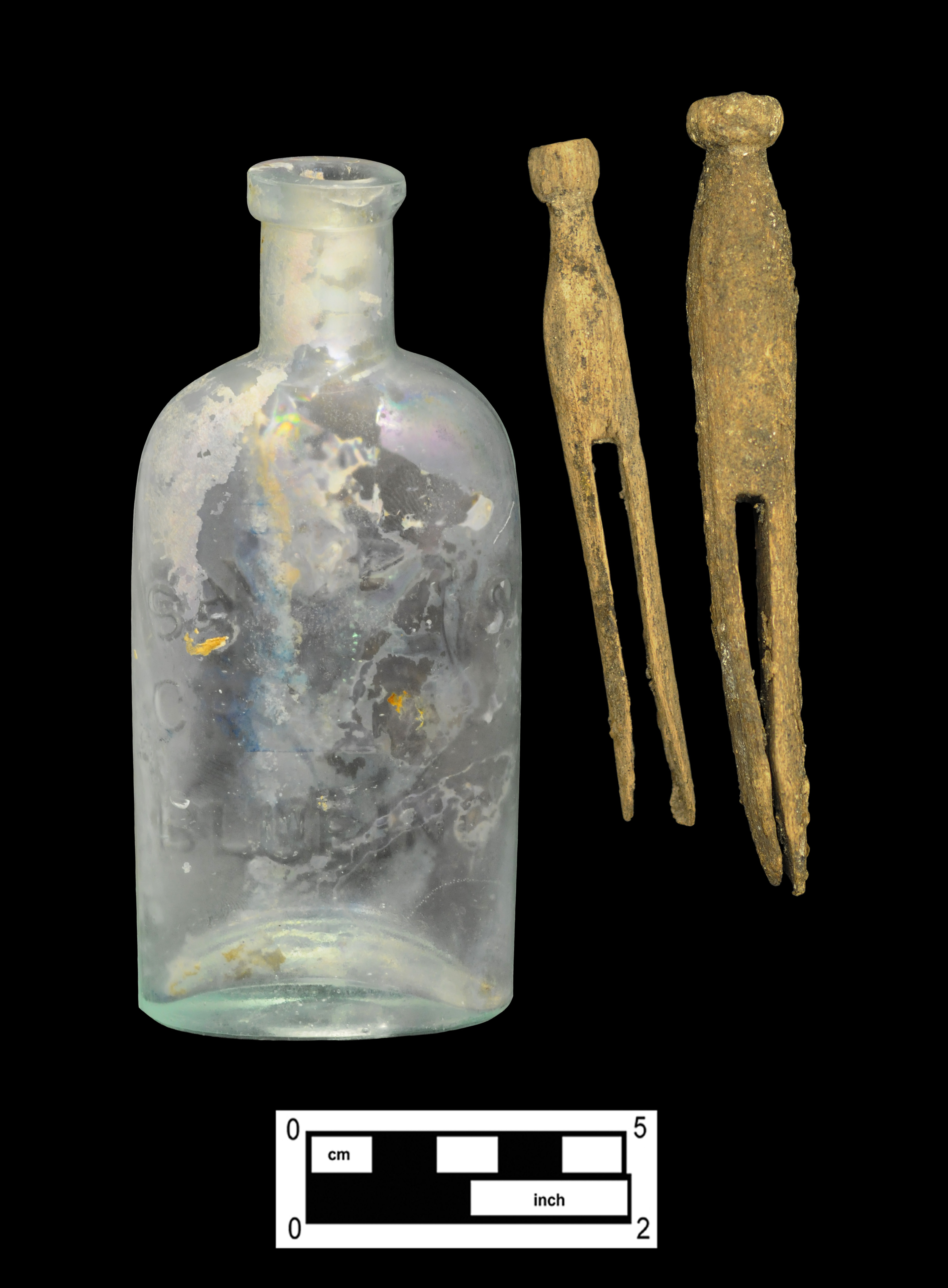Three artifacts are related to a domestic ritual that typically absorbed at least one full day out of each week—the laundry. The women and domestic help in a household primarily performed this task. Depending on the number of people living in a house, the related tasks might consume two to three days each week. In preparation for washing, laundry was sorted, items were mended, and some types of fabric and soiled clothes were pre-soaked. Water might need to be pumped and carried; firewood was required to heat the water, and more water and fuel were needed for rinsing.

One of the recovered artifacts is an aqua glass bottle embossed “Sawyer’s Crystal Blueing” on one side (4A-G-0149). Bluing was added to the rinse water of white fabrics, especially those items that had yellowed over time to make them appear whiter. Information about the product was recorded in a later law suit, stating that Henry Sawyer began producing his bluing in about 1864 in Boston. 1 The court case provides the following description of Sawyer’s bottles:
Among the bluings manufactured by Sawyer and afterwards by the plaintiff is an article known as “Liquid Bluing” which since 1868 or 1869 has had a large sale, and has been put up continuously in a special style of package of the following description: A bottle of light green color having a flat body with rounded shoulders and a neck about an inch long terminating in a rim or lip upon one side of which is blown or moulded in three lines, in large letters, the words “Sawyer’s Crystal Bluing.” 2
The Sawyer Crystal Blue Company brought the law suit against a former employee named Hubbard, who had established his own bluing business. Hubbard was not only using a similar paper label and metal cap, but refilling old, embossed Sawyer’s bottles and applying his paper label. 3 The court ruled in favor of Sawyer and granted an injunction against Hubbard.
An illustration of a similar bottle with a large paper label printed “Sawyers Crystal Blue” appeared with a price list in the Sears, Roebuck & Company catalog of 1897. 4 The recovered bluing bottle dates slightly earlier, however, and matches the description in the court case exactly. The aqua (called “light green” in the court case) bottle features a generic oval form with tooled patent finish and post bottom-molded base. The manufacturing characteristics of the bottle, particularly the tooled finish and lack of air-venting marks, indicate a likely production date range between the mid-1870s and mid-1880s.
Also recovered were two wooden clothes pins most likely used to secure clean, wet laundry to a clothes line while it air dried (Cat # 4.24.564). Although they vary in size, these clothes pins are similar in shape. An article in The Harrisburg Daily Patriot, dated January 2, 1877, described how clothes pins were manufactured:
Insignificant as the common wooden clothes pin is in itself, its manufacture forms no mean part in American industries, and the numerous factories in New England and other states furnishes employment to thousands of persons. There are several large clothes pins manufactories in Pennsylvania and Ohio, and one in the vicinity of Saratoga, New York, each of which is capable of turning out a thousand boxes, 720,000 pins per week… As a rule those engaged in the manufacture of clothes pins are Quakers. Beech, white birch and poplars are the woods used in making the article, the birch and poplars being considered the best. The machinery employed is very simple the wood is first sawed and then cut into small square sticks by means of a cutting machine. Each stick after being rounded in a lathe is passed into another machine which throws out a number of perfectly formed pins at one cut and with great rapidity. The pins are then thrown into a large revolving cylinder and smoothed by friction with each other… 5
These clothes pins and the empty bluing bottle provide a glimpse at a complex household task that was performed on a weekly basis.
References
- Peyton Boyle, ed., Federal Reporter Cases Argued and Determined in the Circuit and District Courts of the United States Oct. 1887–Jan 1888, Vol 32 (St. Paul, MN: West Publishing Co., 1888), 388, 389. ↩
- Boyle, Federal Reporter Cases, 388, 389. ↩
- Boyle, Federal Reporter Cases, 388, 389. ↩
- Sears, Roebuck, Sears, Roebuck Catalogue, 1897 Edition (New York, NY: Republished by Chelsea House 1968), 19. ↩
- “The Making of Clothes Pins,” The Harrisburg Daily Patriot (Harrisburg, PA), January 2, 1877, p. 1, Genealogy Bank, subscription database accessed August 2014, http://www.genealogybank.com. ↩







